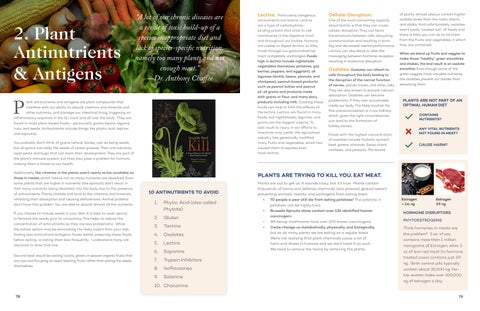2. Plant Antinutrients & Antigens
“A lot of our chronic diseases are a result of toxic build-up of a species inappropriate diet and lack of species-specific nutrition, namely too many plants and not enough meat.” —Dr. Anthony Chaffee
P
lant antinutrients and antigens are plant compounds that interfere with our ability to absorb vitamins and minerals and other nutrients, and damage our intestinal lining, triggering an inflammatory response in the G.I. tract and all over the body. They are found in most plant-based foods– particularly grains, beans, legume, nuts, and seeds. Antinutrients include things like phytic acid, leptins, and saponins. You probably don’t think of grains (wheat, barley, rye) as being seeds, but all grains are really the seeds of cereal grasses. Their antinutrients repel pests and bugs that can harm their development. They are part of the plant’s immune system, but they also pose a problem for humans, making them a threat to our health.. Additionally, the vitamins in the plants aren’t nearly as bio-available as those in meats, which means not as many nutrients are absorbed. Even some plants that are higher in nutrients (like spinach) don’t result in that many nutrients being absorbed into the body due to the presence of antinutrients. Plants chelate and bind to the vitamins and minerals, inhibiting their absorption and causing deficiencies. Animal proteins don’t have this problem. You are able to absorb almost all the nutrients. If you choose to include seeds in your diet, it is best to soak, sprout, or ferment the seeds prior to consuming. This helps to reduce the concentration of antinutrients so they are less problematic. While the safest option may be eliminating the likely culprit from your diet, finding less antinutrient/antigenic foods, better preparing these foods before eating, or eating them less frequently. I understand many are reluctant to draw that line. Second best would be eating locally grown, in season organic fruits that are ripe and focusing on seed-bearing fruits rather than eating the seeds themselves.
Cellular Disruption:
antinutrients are lectins. Lectins are a type of carbohydratebinding protein that stick to cell membranes in the digestive tract and throughout our bodies. Humans are unable to digest lectins, so they travel through our gastrointestinal tract completely unchanged. Foods high in lectins include nightshade vegetables (tomatoes, potatoes, goji berries, peppers, and eggplant), all legumes (lentils, beans, peanuts, and chickpeas), peanut-based products such as peanut butter and peanut oil, all grains and products made with grains or flour, and many dairy products including milk. Cooking these foods can help to limit the effects of the lectins. Lectins are found in many foods, but nightshades, legumes, and grains are the biggest culprits. To add insult to injury, in our efforts to maximize crop yields, the agriculture industry has genetically modified many fruits and vegetables, which has caused them to express even more lectins.
One of the most concerning aspects about lectins is that they can cause cellular disruption. They can block transmissions between cells disrupting communication and resulting in brain fog and decreased mental performance. Lectins can also block or alter the messaging between hormone receptors resulting in endocrine disruption.
Oxalates: Oxalates can attach to cells throughout the body leading to the disruption of the normal function of nerves, glands, bones, and other cells. They are also known to prevent calcium absorption. Oxalates can become problematic if they over accumulate inside our body. The likely location for this overaccumulation is in our kidneys which, given the right circumstances, can lead to the formation of kidney stones.
of plants almost always contain higher oxalate levels than the roots, stems, and stalks. And unfortunately, oxalates aren’t easily “cooked out” of foods and there is little you can do to rid them from the fruits and vegetables in which they are contained. When we blend up fruits and veggies to make those “healthy” green smoothies and shakes, the end result is an oxalate smoothie. Even though some of the green veggies have valuable nutrients, the oxalates prevent our bodies from absorbing them.
PLANTS ARE NOT PART OF AN OPTIMAL HUMAN DIET CONTAINS NUTRIENTS? ANY VITAL NUTRIENTS NOT FOUND IN MEAT?
Foods with the highest concentration of oxalates include rhubarb, spinach, beet greens, almonds, Swiss chard, cashews, and peanuts. The leaves
CAUSE HARM?
PLANTS ARE TRYING TO KILL YOU. EAT MEAT. 10 ANTINUTRIENTS TO AVOID 1.
Phytic Acid (also called Phytate)
2.
Gluten
3.
Tannins
4.
Oxalates
5.
Lectins
6.
Saponins
7.
Trypsin Inhibitors
8.
Isoflavaones
9.
Solanine
10. Chaconine 78
Lectins: Particularly dangerous
Plants are out to get us. It sounds crazy, but it’s true. Plants contain thousands of toxins and defense chemicals (aka poisons) geared toward preventing animals, insects, and pathogens from eating them. • 70 people a year still die from eating potatoes! The solanine in potatoes can be highly toxic. • Brussels Sprouts alone contain over 136 identified human carcinogens • Whitecap mushrooms have over 100 known carcinogens • Carbs change us metabolically, physically, and biologically, but so do many plants we are eating on a regular basis. We’re not realizing that plant chemicals cause a lot of harm and illness in humans and we don’t treat it as such. We need to remove the toxins by removing the plants.
Estrogen > 1m ng
Estrogen 3.9 ng
HORMONE DISRUPTORS PHYTOESTROGENS Think hormones in meats are the problem? 3 oz. of soy contains more than 1 million nanograms of Estrogen, while 3 oz of lean red meat (in hormone treated cows) contains just 3.9 ng. Birth control pills typically contain about 35,000 ng. Fertile women make over 100,000 ng of estrogen a day.
79






